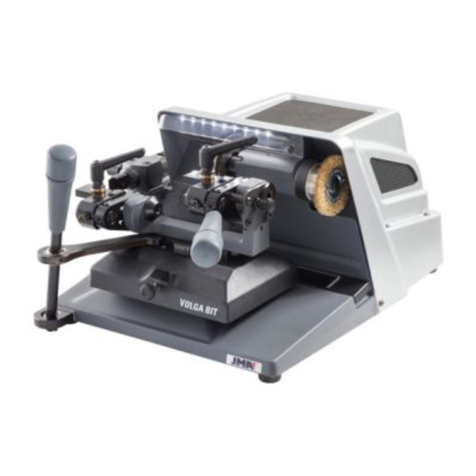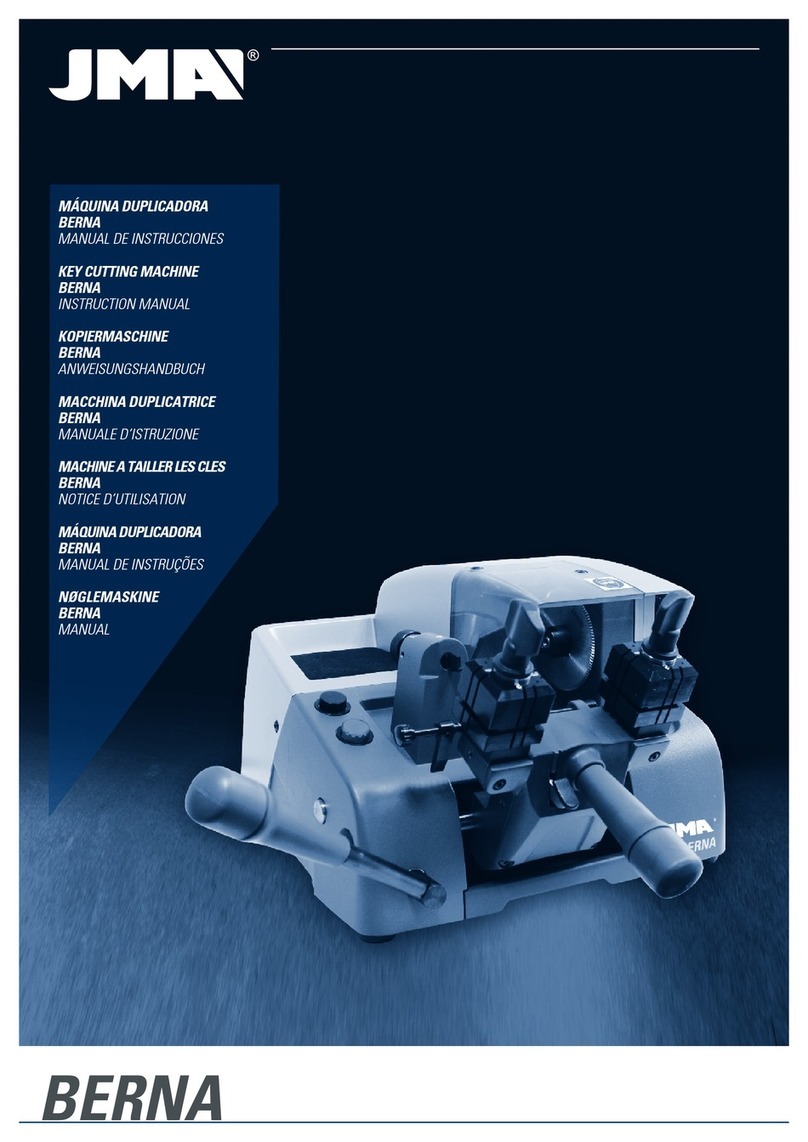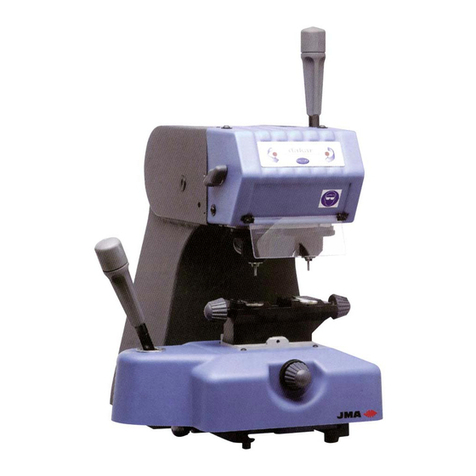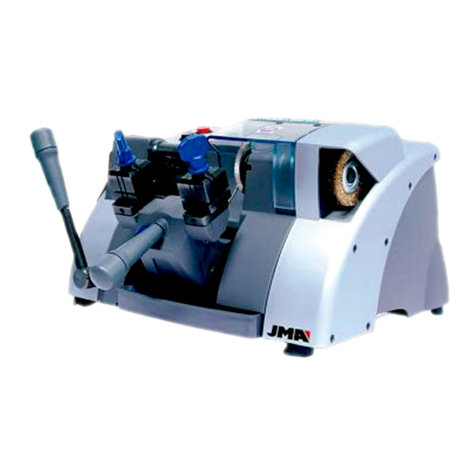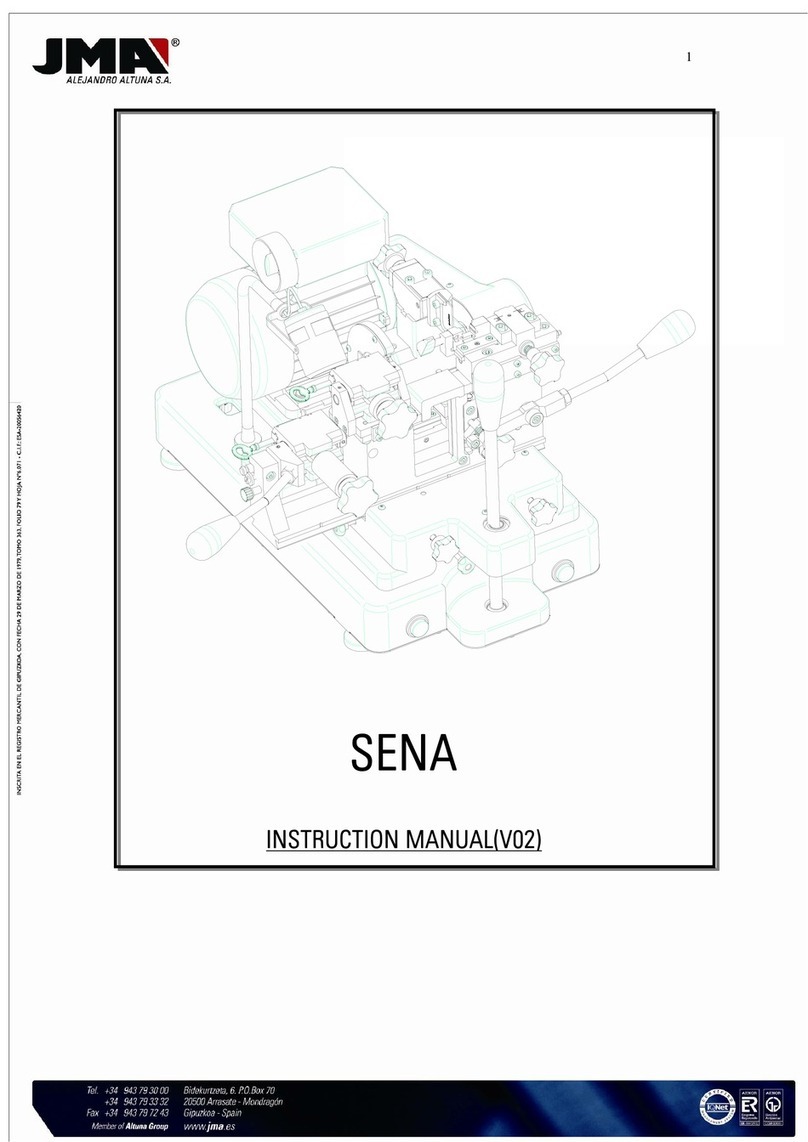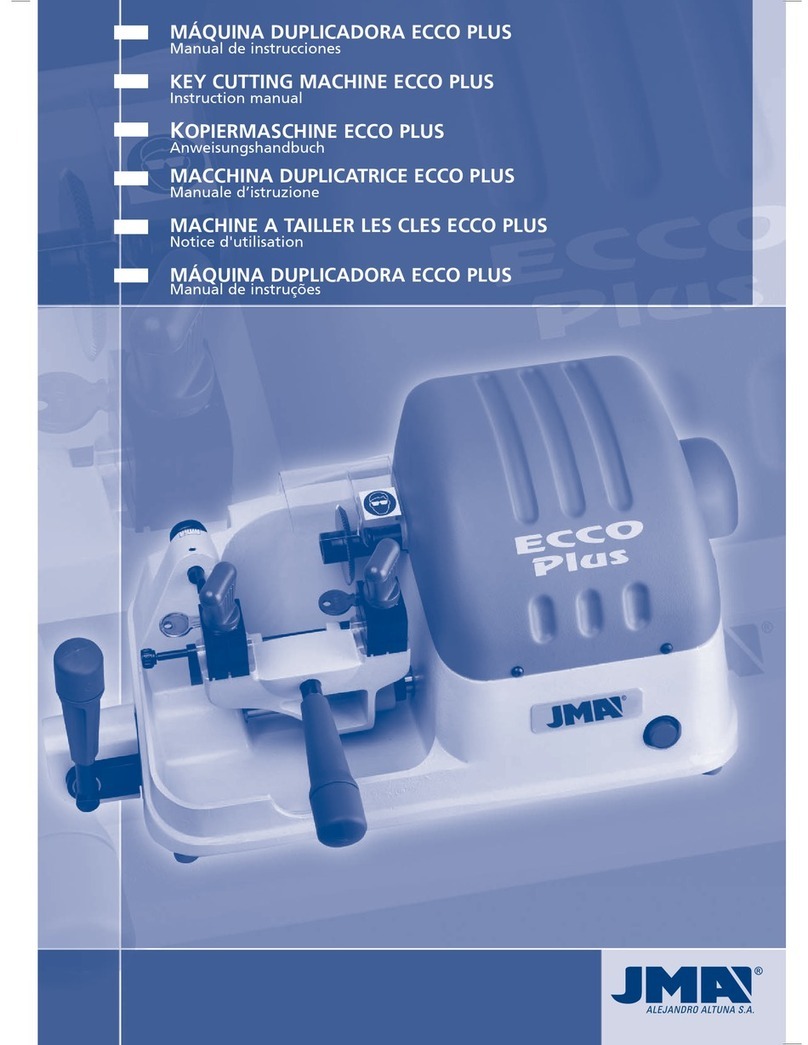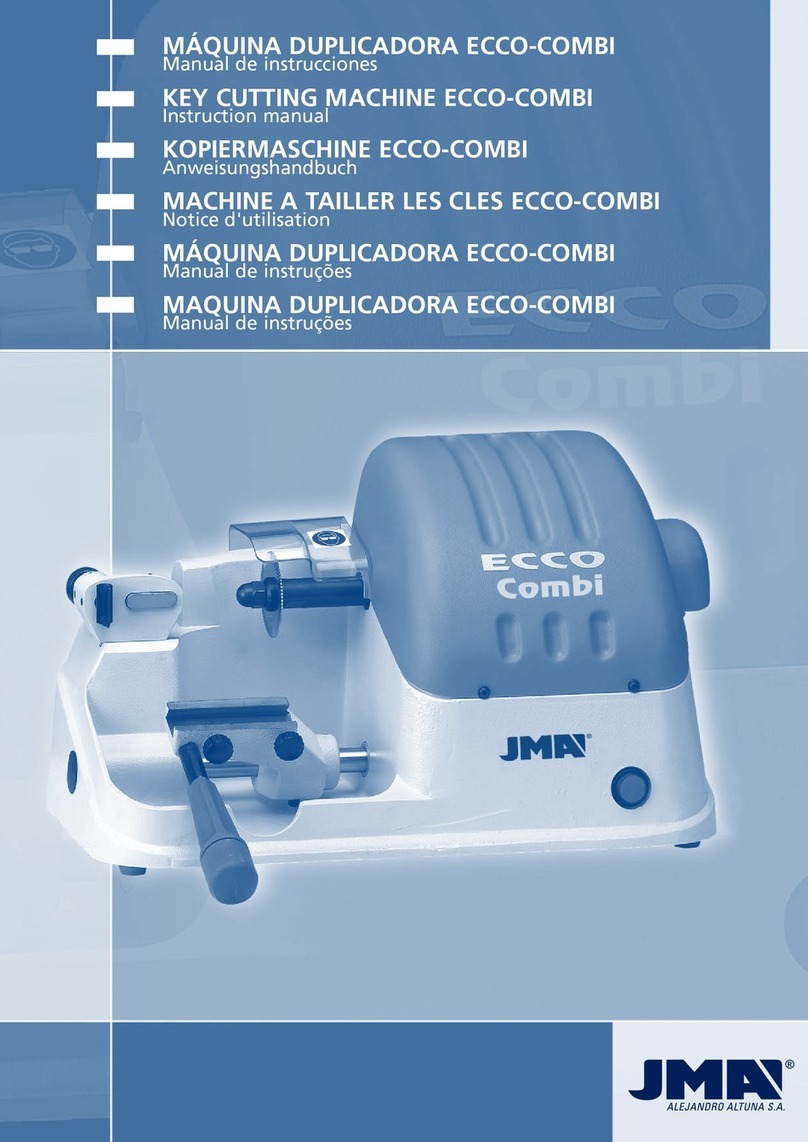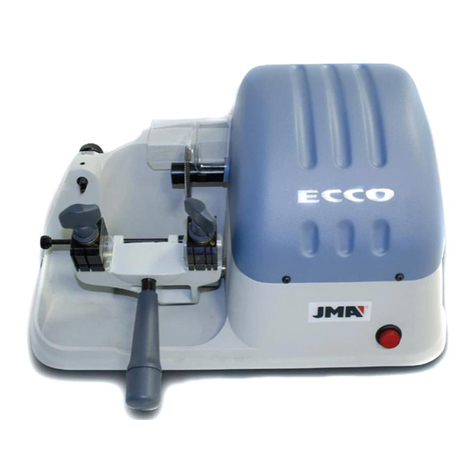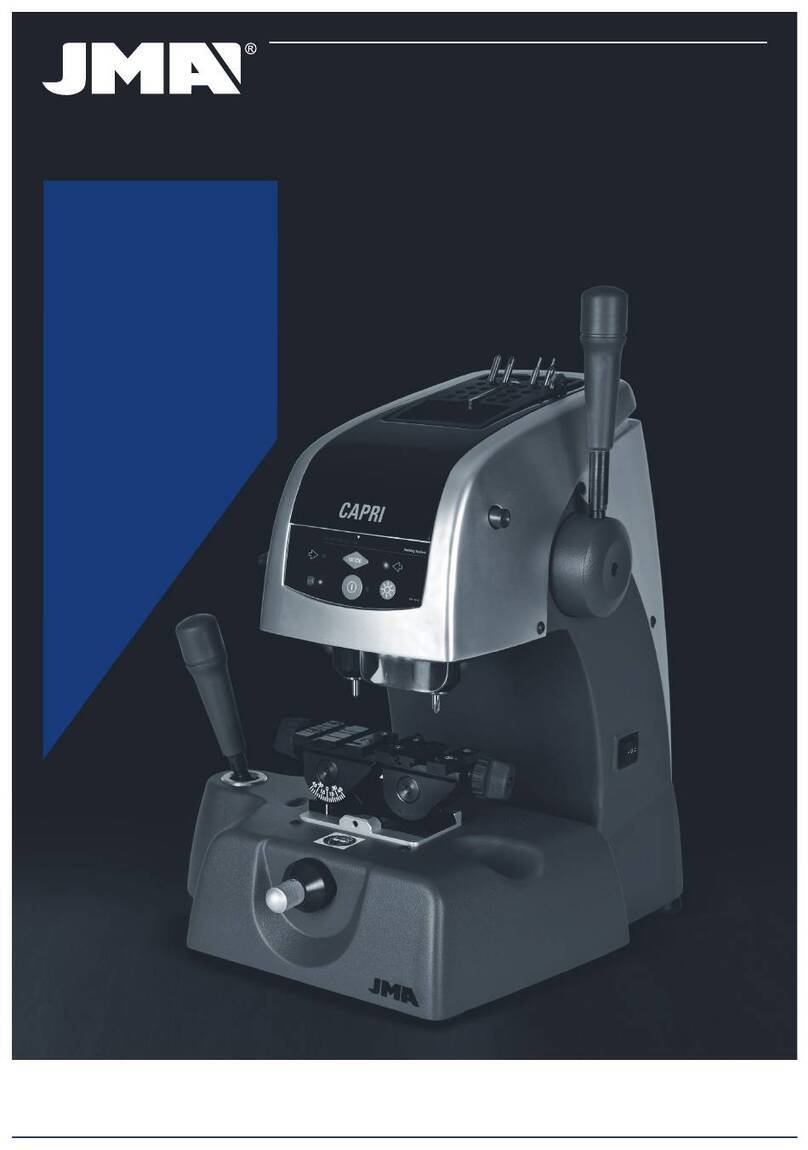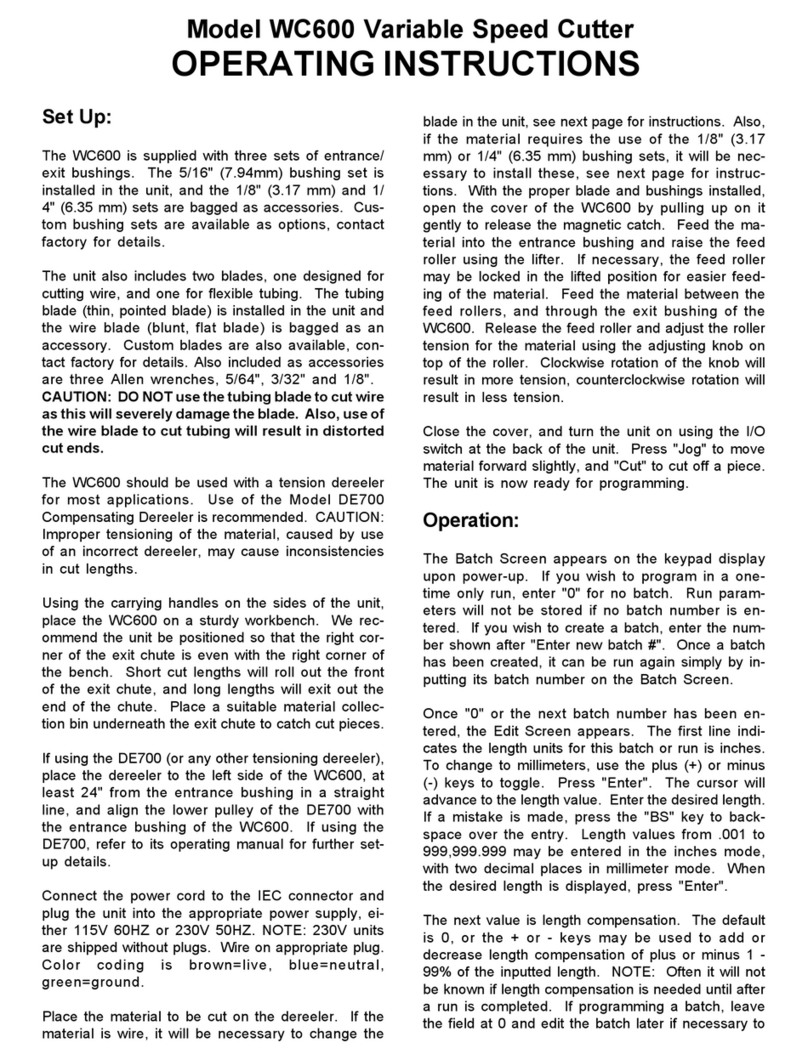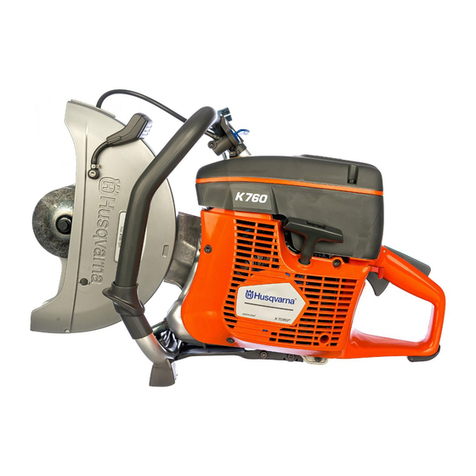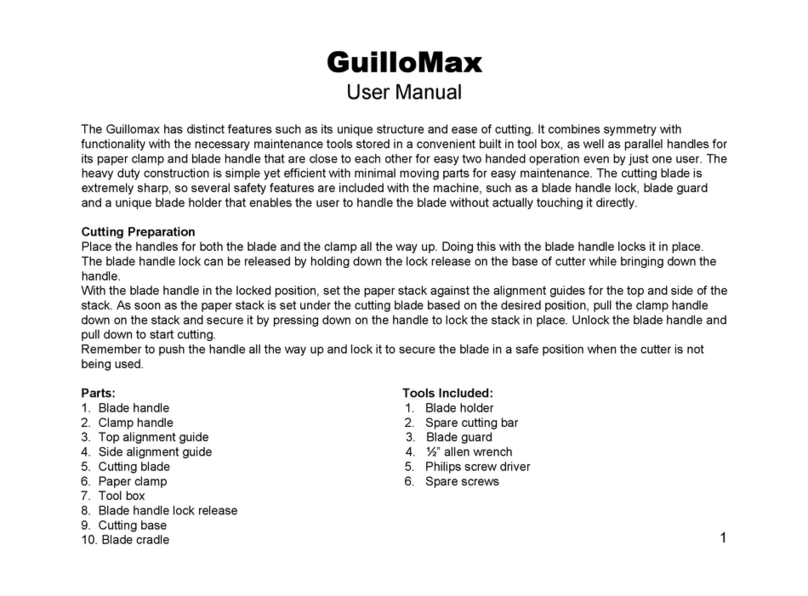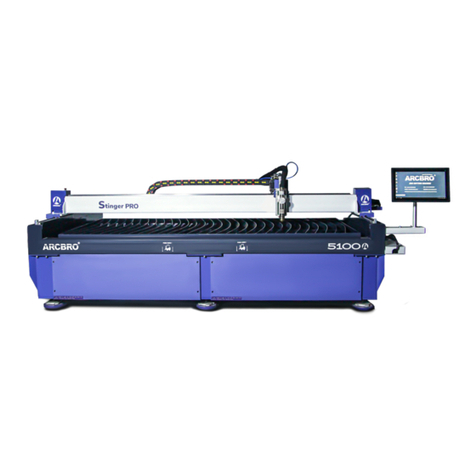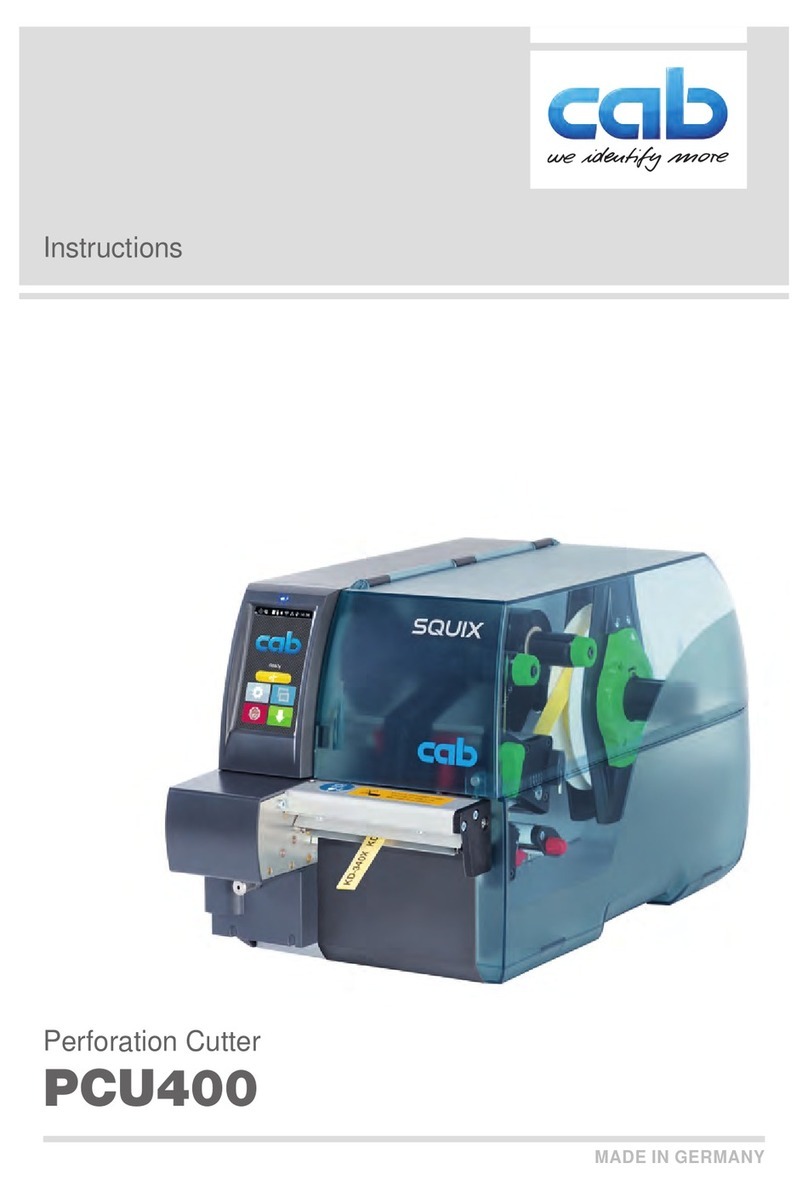
español
10) Colocar la herramienta alineada con el otro tornillo de amarre de la garra, y volver
a realizar la misma operación.
11) Revisar de nuevo que las garras han quedado regladas en esas dos posiciones
(frente a los tornillos de amarre), y si fuese necesario, retocar ligeramente la posición
de la garra apretando muy ligeramente el correspondiente tornillo prisionero.
12) Ya se ha realizado el reglaje, por lo que ahora hay que apretar con fuerza los dos
tornillos de amarre de la garra.
13) Por último, apretar un poco los dos prisioneros de regulación de la garra. De esta
manera, aseguramos una mayor consistencia en la fijación de la garra que hemos re-
glado.
4.3 SUSTITUCIÓN DE LOS FUSIBLES
En el caso de que la máquina no se ponga en marcha cuando se accionen los interrup-
tores de marcha, es necesario comprobar los fusibles. Esta operación se realiza de la
siguiente manera:
1) Apagar la máquina mediante el interruptor general y desconectar el cable de ali-
mentación.
2) Extraer el porta-fusible que se encuentra debajo del interruptor general.
3) Comprobar (usar un tester) si algún fusible está fundido, y en su caso, sustituirlo
por otro del mismo tipo y valor.
4.4 TENSADO Y SUSTITUCIÓN DE LA CORREA
Para revisar el tensado de la correa o para sustituir la misma, deben seguirse los si-
guientes pasos:
1) Apagar la máquina mediante el interruptor general, y desconectar el cable de ali-
mentación.
2) Desatornillar los 4 tornillos (5) que amarran el “guarda del cabezal” y extraerlo.
Los tornillos se encuentran en el lateral derecho, en el lateral izquierdo, en la parte
superior, y en la parte trasera. Para poder extraer el “guarda del cabezal”, es necesario
introducir previamente y hasta su tope, el “pulsador de bloqueo de la fresa” (E).
3) Aflojar pero sin soltar, los 4 tornillos (6) que sujetan el motor.
4) Aflojar pero sin soltar, las 2 tuercas de contratuerca (7).
Tensado: Girando los dos tornillos de tensado (8), se produce el desplazamiento
del motor hacia la parte trasera de la máquina. Cuando se observe que la correa dispo-
ne de la tensión requerida, volver a apretar las dos tuercas de contratuerca (7), y los
tornillos (6) que sujetan el motor.
Sustitución: Aflojar pero sin soltar, los 2 tornillos de tensado de la correa (8).
Extraer la correa estropeada y sustituirla por una nueva. Girando los dos tornillos de
tensado (8), se produce el desplazamiento del motor hacia la parte trasera de la máqui-
na. Cuando se observe que la correa dispone de la tensión requerida, volver a apretar
las dos tuercas de contratuerca (7), y los tornillos (6) que sujetan el motor.
5) Volver a colocar y amarrar el “guarda del cabezal”.
Ver Fig. 22
4.5 SUSTITUCIÓN DEL MOTOR
Esta operación se realiza de la siguiente manera:
1) Apagar la máquina mediante el interruptor general, y desconectar el cable de ali-
mentación.
2) Desatornillar los 4 tornillos (5) que amarran el “guarda del cabezal” y extraerlo.
Los tornillos se encuentran en el lateral derecho, en el lateral izquierdo, en la parte
superior, y en la parte trasera. Para poder extraer el “guarda del cabezal”, es necesario
introducir previamente y hasta su tope, el “pulsador de bloqueo de la fresa” (E).
3) Desatornillar los 6 tornillos (9) que amarran el “guarda del motor” (F) y extraerlo.
4) Extraer la correa (G).
5) Desconectar los cables de alimentación que llegan hasta el motor.
6) Desatornillar los 4 tornillos (6) que sujetan el motor.
7) Extraer el motor.
8) Accediendo a la parte inferior del motor con un destornillador plano, bloquear el
eje del motor y manualmente girar la polea (H) hasta extraerla (la rosca es a izquierdas).
9) Desenroscar los 4 tornillos (10) que amarran la chapa-soporte del motor y extraer-
la.
10) Para montar el nuevo motor, efectuar las mismas operaciones pero de manera
inversa.
Ver Fig. 23
4.6 SUSTITUCIÓN DEL DISPLAY-TECLADO
Esta operación se realiza de la siguiente manera:
1) Apagar la máquina mediante el interruptor general, y desconectar el cable de ali-
mentación.
2) Desatornillar los 4 tornillos (5) que amarran el “guarda del cabezal” y extraerlo.
Los tornillos se encuentran en el lateral derecho, en el lateral izquierdo, en la parte
superior, y en la parte trasera. Para poder extraer el “guarda del cabezal”, es necesario
introducir previamente y hasta su tope, el “pulsador de bloqueo de la fresa” (E).
3) Desconectar el cable plano, que conecta el display-teclado (K) con la tarjeta elec-
trónica de control.
4) Despegar el viejo display-teclado (K) del “Guarda del cabezal”, y extraerlo.
5) Para montar el nuevo display-teclado, efectuar las mismas operaciones pero de
manera inversa.
Ver Fig. 24
4.7 SUSTITUCIÓN DE LA TARJETA ELECTRÓNICA DE
CONTROL
Esta operación se realiza de la siguiente manera:
1) Apagar la máquina mediante el interruptor general, y desconectar el cable de ali-
mentación.
2) Desatornillar los 4 tornillos (5) que amarran el “guarda del cabezal” y extraerlo.
Los tornillos se encuentran en el lateral derecho, en el lateral izquierdo, en la parte
superior, y en la parte trasera. Para poder extraer el “guarda del cabezal”, es necesario
introducir previamente y hasta su tope, el “pulsador de bloqueo de la fresa” (E).
3) Desconectar el conector principal de la tarjeta electrónica de control (L)
4) Desconectar el cable plano, que conecta el display-teclado con la tarjeta electró-
nica de control (L).
5) Desatornillar los 3 tornillos (11) que sujetan la tarjeta electrónica de control (L) al
“guarda del cabezal”, y extraerla.
6) Para montar la nueva tarjeta electrónica de control, efectuar las mismas operacio-
nes pero de manera inversa.
Ver Fig. 25
4.8 SUSTITUCIÓN DE LA TARJETA DE POTENCIA Y DEL
DISYUNTOR
Esta operación se realiza de la siguiente manera:
1) Apagar la máquina mediante el interruptor general, y desconectar el cable de ali-
mentación.
2) Desatornillar las 4 patas (P) de la máquina, y extraerlas.
3) Desatornillar los 5 tornillos (12) que amarran la “Chapa de protección inferior”, y
retirarla.
4) Desconectar todos los cables de la tarjeta que queramos reemplazar, anotando
previamente la posición de cada cable.
5) Para liberar la tarjeta de potencia (M) o el disyuntor (N), basta con presionar sobre
las lengüetas de cada uno de los 4 pivotes que la sustentan, y tirar de la tarjeta hacia
arriba.
6) Para montar la nueva tarjeta de potencia o el nuevo disyuntor, efectuar las mismas
operaciones pero de manera inversa.
Ver Fig. 26
5.- SEGURIDAD
Para su seguridad, le recomendamos que siga las siguientes pautas:
• Nointentearrancaromanipularlamáquinahastaquetodoslostemasdeseguri-
dad, instrucciones para la instalación, guía del operario y procedimientos de manteni-
miento, hayan sido cumplimentados y entendidos.
• Desconectesiempreelsuministroeléctrico,antesderealizarcualquiertrabajode
limpieza o mantenimiento.
• Mantengalamáquinasiemprelimpia,asícomosuentorno.
• Trabajarconlasmanossecas.
• Utilizarsiempregafasdeprotección,aunquelamáquinayadispongadeproteccio-
nes.
• Asegúresedequelamáquinatengatomaatierra.
Recomendamos trabajar con la máquina a una altura en la cuál el usuario se encuentre
cómodo:
• Lomásrecomendableestrabajarsentadoenunasilla.Ajustarlaalturadelasilla
hasta que los ojos del usuario queden a la altura de la parte más superior de la máqui-
na.
• Sisetrabajadepie,dependiendodelaalturadelusuarioesrecomendablecolocar
un alzador entre la mesa y la máquina, de manera que los ojos del usuario queden a la
altura de la parte más superior de la máquina.






